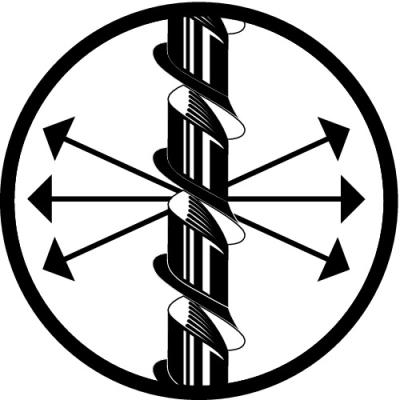
Bestway Products Company offers a full line of Spyral saw blades that enable the tight, intricate cuts that are virtually impossible with conventional flat saw blades. Designed with a single continuous cutting tooth that spirals 360° around the length of a hardened steel wire, the Spyral saw blades cut materials ranging from metals, plastics and ceramics to rubber, graphite and wood to make them ideal for many building, machining, crafting and fabrication applications.
“Conventional toothed saw blades are typically flat, cut in a forward direction and need to be positioned so the teeth face the material at the right angle,” says Stuart Gordon, the company’s owner & president. “Our Spyral saw blades cut in all directions, even sideways and backwards. They will cut in the direction of the feed pressure, which can make a significant difference when cutting without rigid fixturing. While other wire blades are limited to cutting only certain types of foam or require machinery that can cost hundreds of thousands of dollars, our Spyral saw blade can cut a greater assortment of materials including foams as well as wood and many metals without requiring costly specialized CNC machinery.
“As a result, the Spyral saw blade is a real problem solver since it can do the extremely intricate work that would be far more difficult or expensive with other products. In comparison to conventional saw blades that need to be rotated to prevent breakage, the Spyral blade also cuts sharper angles, curves, notches and contours without being rotated in the saw. To the best of our knowledge, there isn’t an identical product in the market.”
Custom designed and built in-house, the company’s Spyral blades can be cut to specific lengths to meet the individual needs of customers. For example, manufacturers have used these products to manufacture, create or shape everything from welding torch tip cleaners and broken key extractors to ceramic greenware tools, decorative bow machine needles and the foam bottoms of floral arrangements. The Spyral saw blade product line is also ideal for servicing the intricate cutting needs of numerous industries:
- Foam Fabrication: Cut notches, grooves or contours in foam materials. Much faster than hotwire in thermoplastics. Can be used with portable or fixed reciprocating saws as well as bandsaws.
- Trim large molded surfaces
-- Rough out shapes for sculpting or machining
-- Cut coated foam and bonded foam structures
Packaging: Cut custom shapes in packaging material. Used for custom instrument cases and prototyping
- Insulation: Cuts insulation material including fiberglass, rock wool, cellulose, polyiso, phenolic and cement foam with or without facings
- Aerospace: Friction cut contours and trimming formed Titanium sheet. Cut contours in composite materials, core materials, and structures
- Tools and Machine components: The Spyral blade’s unique configuration also makes it perfect for wide-ranging component applications:
-- Welding torch tip cleaners
-- Needles for ribbon bow machines
-- Locksmith tools for extracting broken keys
-- Round files for slotting pipe stems
-- Wax sawblades for lost wax casting
-- Ceramic sculptor’s tools for shaping greenware
-- Hand sawblades used in a variety of repair and maintenance operations
-- Loose sling saws for separating paper rolls in manufacturing
-- Clearing snags in extrusion lines
Contact Details
Related Glossary Terms
- ceramics
ceramics
Cutting tool materials based on aluminum oxide and silicon nitride. Ceramic tools can withstand higher cutting speeds than cemented carbide tools when machining hardened steels, cast irons and high-temperature alloys.
- computer numerical control ( CNC)
computer numerical control ( CNC)
Microprocessor-based controller dedicated to a machine tool that permits the creation or modification of parts. Programmed numerical control activates the machine’s servos and spindle drives and controls the various machining operations. See DNC, direct numerical control; NC, numerical control.
- extrusion
extrusion
Conversion of an ingot or billet into lengths of uniform cross section by forcing metal to flow plastically through a die orifice.
- feed
feed
Rate of change of position of the tool as a whole, relative to the workpiece while cutting.
- flat ( screw flat)
flat ( screw flat)
Flat surface machined into the shank of a cutting tool for enhanced holding of the tool.
- sawing machine ( saw)
sawing machine ( saw)
Machine designed to use a serrated-tooth blade to cut metal or other material. Comes in a wide variety of styles but takes one of four basic forms: hacksaw (a simple, rugged machine that uses a reciprocating motion to part metal or other material); cold or circular saw (powers a circular blade that cuts structural materials); bandsaw (runs an endless band; the two basic types are cutoff and contour band machines, which cut intricate contours and shapes); and abrasive cutoff saw (similar in appearance to the cold saw, but uses an abrasive disc that rotates at high speeds rather than a blade with serrated teeth).
- shaping
shaping
Using a shaper primarily to produce flat surfaces in horizontal, vertical or angular planes. It can also include the machining of curved surfaces, helixes, serrations and special work involving odd and irregular shapes. Often used for prototype or short-run manufacturing to eliminate the need for expensive special tooling or processes.
- slotting
slotting
Machining, normally milling, that creates slots, grooves and similar recesses in workpieces, including T-slots and dovetails.







